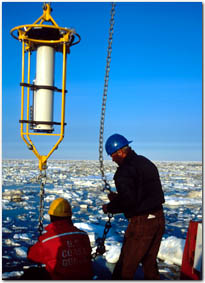
|
 |
Science Highlights > A Climate Canary in the Coal Mine
A Climate Canary in the Coal Mine
 |

Click to enlarge
|
|
Senior Engineering Assistant John Kemp, standing, guides an acoustic Doppler current profiler through ice in the Arctic Ocean. (Photo by Christopher Linder) |
The Arctic has been described as an environmental “canary in a coal mine” likely to send the first warning signals of climate change. Understanding this isolated, delicately balanced ocean at the top of the world is critical to understanding climate all the way down to the tropics.
During the summer of 2002, a WHOI science team led by physical oceanographer Bob Pickart launched a three-year effort to observe one of the world’s least-studied bodies of water. The team is investigating how Pacific-origin waters that move across the Chukchi and Beaufort shelves penetrate the deep interior of the Western Arctic.
Pickart and colleagues are particularly interested in the behavior of the cold “halocline,” the layer of salty water 150 to 200 meters (500 to 650 feet) below the surface. The halocline acts as a barrier between ice at the surface and a reservoir of warmer water at depth. If this shield is weakened, there is enough heat stored in the deep water to melt or reduce the polar ice cover, likely altering global ocean current systems, Earth’s albedo (reflecting capability), and the Arctic food web.
To characterize this important gateway, researchers deployed an array of eight moorings, a “picket fence” of profiling instruments extending 40 kilometers (25 miles) across the edge of the Beaufort Sea. A complementary array was set up in the Chukchi Sea by researchers from the universities of Washington and Alaska. The picket fence approach is new in a region where scientists have typically been limited to one or two “fence posts.” With this continuous, high-resolution series of data, scientists hope to gain a better view of how the Western Arctic Ocean varies on seasonal and longer time scales, and how such changes reflect or presage climate change.
The WHOI portion of the Western Arctic Shelf-Basin Interactions program was funded by the Office of Naval Research, with additional support from Gratia Rinehart Montgomery.
|
|
